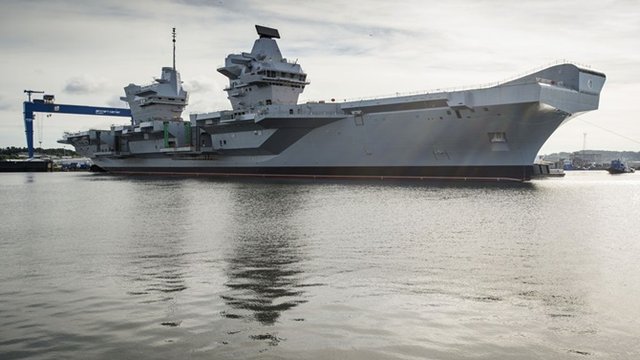Warning Of Delays To New Portsmouth Aircraft Carriers
16 March 2017, 06:05

A spending watchdog's warning a shortage of key personnel could affect the deployment of two new Royal Navy super carriers, which will be based in Portsmouth.
The National Audit Office report also raises concerns about 'technical issues' which could mean the first Queen Elizabeth aircraft carrier may not be operational by the end of 2020, as scheduled.
But it says the Ministry of Defence has made 'good progress' - with the ship due to arrive at Portsmouth Naval Base this summer.
The MoD tells us it 'will have the people' it needs, and technical issues are expected during such a complex programme.
While the MoD has begun a recruitment programme to address the gaps, the NAO said the number of pilots was expected to be ``just sufficient'' to 2026, with ``limited resilience'' if personnel left the forces.
``The department still has a lot to do as it brings together equipment, trained crews, infrastructure and support. Problems in any of these areas could mean that use of the carriers is delayed or reduced,'' the NAO said.
``The next three years are critical as the programme moves into a high-risk period of trials, testing and training. The technology is innovative and operational unknowns, which will only become clear during testing, may affect plans and increase costs.
``To recover earlier delays, the department has already compressed the timetable and is running some testing in parallel with other tasks.
``The closely timed sequence of tasks offers no further room for slippage and there remain significant risks to value for money.''
The NAO said the MoD was already facing a 1% to 2% cost overrun on the £6.2 billion budget for building the ships, while the forecast £5.8 billion earmarked for the US-built Lightning II fighters could be affected by fluctuations in the value of sterling.
In the longer term, the NAO said the deployment of the carriers would have far-reaching implications for the way the Navy operates with a ``significant proportion'' of the fleet required to support and protect them.
The formation of a carrier task group is likely to account for about 27% of the Navy's fleet by tonnage and 20% of the personnel needed to crew the fleet.
``Currently, the Navy carries out multiple operations concurrently using single ships. This means the Navy will need to change fundamentally how it operates and make judgements on priorities,'' the NAO said.
The MoD acknowledged that the carrier programme faced ``challenges'' but said it remained committed to getting both ships fully operational by 2026. A spokesman said:
"The introduction of the largest warships ever built for the Royal Navy, the Queen Elizabeth Class aircraft carriers, together with our F-35 jets, and the Crowsnest surveillance system, will transform our ability to project power around the world. We welcome the NAO's recognition of the progress we have made in bringing them into service.
"HMS Queen Elizabeth will be accepted by the Royal Navy as planned this year and we will also take delivery of a further 6 F-35s in addition to the 8 already delivered. With sea trials expected to start in the summer, we recognise that there are challenges ahead and remain committed to delivering the full range of joint F-35 and Carrier operations by 2026.
"Work is progressing well for Portsmouth to be the base of both new Queen Elizabeth Class carriers. Over £100m is being spent updating and enhancing the facilities in the dockyard to make it ready for the arrival. Work to ready the jetty has been completed, allowing USS Robert Peary to pull alongside last week as part of testing the facilities.
"The Royal Navy has also dredged the approach channel, inner harbour area and berth to make them deep and wide enough for the new ships, moving three million cubic metres of clay, sand and gravel from an area the size of 200 football pitches. Bespoke navigational lights, a high-voltage electrical supply and specialist carrier-specific gangways, known as 'brows' are also being provided as part of this huge programme of works."






